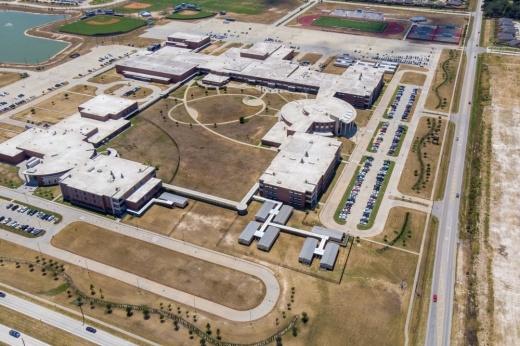At a July 31 meeting, KISD’s board of trustees voted to call a bond election featuring four propositions for voters to consider. The largest bond proposition—Proposition A at $722.99 million—aims to address overcrowding across Katy ISD through new schools and renovations.
Data from demographic firm Population and Survey Analysts data projects KISD will grow 6.2% from 95,104 students in 2023-24 to 101,000 students by the 2027-28 school year, district officials said in an emailed statement. Ten of 14 campuses in the northwest quadrant of the district—where population growth is most significant—are currently at or near capacity, according to district documents.
PASA Chief Data Analyst Kris Poole said even the opening of two new secondary schools in northwest KISD in August 2024 along with proposed attendance boundary modifications are hardly enough to counter the residential development in the area.
“This would put Katy Manor [Preserve], the Marasol [Community], Katy Crossing, Katy Lakes, Elyson, Winward, the future Aniston and parts of the future Sunterra all in that new [junior high] school,” Poole said. “There’s an awful lot going on.”
In addition to new schools, other propositions focus on purchasing instructional laptops, updating high school natatoriums and improving athletic facilities.
District challenges
The overall enrollment growth in KISD has outpaced other Greater Houston-area districts in the last five years.
The district has gained more students from 2017-18 to 2022-23 than other Houston-area districts—adding 15,145 students. To compare, Lamar CISD gained 10,315 students, and Houston ISD lost 24,241 students in the same timeframe, according to PASA data.
While forming the 2023 bond committee, KISD Chief Operations Officer Ted Vierling said that even with the opening of two new schools in fall 2024, enrollment projections for the 2027-28 school year would still overcrowd secondary campuses in the northwest quadrant of the district, which is north of I-10 and west of the Grand Parkway.
To address growth in the meantime, officials have called for adjusted attendance boundaries to provide some population relief at several secondary schools in the northwest area of KISD. Vierling said these suggested boundary modifications will likely be approved in October after public comment periods and notifications to the affected families.
At a June 26 meeting, Poole and Vierling said these changes would account for the opening of Junior High 18 and High School 10 in August 2024, and are an attempt to manage population growth over the next three years.
During a July 24 workshop meeting, Trustee Rebecca Fox said renovations to older facilities are just as important as adding new schools.
“As our district grows, our responsibility to older schools [increases],” Fox said. “There’s inflation, but there’s also a whole lot more buildings and a whole lot more students using our buildings.”
Bond initiatives
This year’s bond was designed to not increase the property tax rate and would address the district’s most pressing needs, such as capacity challenges and dwindling state funding, Board President Victor Perez said in an Aug. 1 news release.
The largest portion of the bond package is Proposition A at $722.99 million. Projects include purchasing land and constructing three elementary schools and one junior high in the northwest area of the district; renovating aging campuses throughout the district; installing security fencing; upgrading security cameras; purchasing school buses; and updating building components districtwide.
Proposition B is the next most cost-significant piece of the bond program at $83.57 million. This includes working to provide each student with a district-monitored laptop for instructional use for students in grades 3-12.
Trustee Lance Redmon, who was a committee member on the community bond advisory committee, said the 1-to-1 device model was pitched and approved because of requirements that the State of Texas Assessments of Academic Readiness, or STAAR, be administered online.
Proposition C, priced at $4.2 million, would renovate competition swimming pools, called natatoriums, at high school campuses. Finally, Proposition D encompasses repairs to districtwide athletic facilities and Rhodes Stadium. This item would cost $29.88 million.
Community responsibility
Should the bond pass, KISD would continue a streak of taking on hundreds of millions in bonds every two to three years. This strategy was confronted by Perez, who said voters may grow fatigued of the continuous ask.
“When you look at the big picture of where we came from, where we’re going and where we continue to go, the concern is just kind of the bond on top of bonds,” Perez said at the July 24 workshop. “We’re building fewer schools, but we’re having to feed the existing schools and then add the technology, so it’s a concern of mine in terms of ... the debt.”
In May 2021, voters approved a $676.2 million bond with similar projects—including six new schools, expansions, technology, safety, buses, and portable buildings for over-capacity schools. According to district documents, 83% of those projects have been completed or are in planning.
KISD Chief Financial Officer Christopher Smith said although the process of putting together bond packages may cause administrative fatigue, a 2023 bond would help the district avoid student overcrowding and prevent additional pressure on the general operating fund.
At the July 24 board of trustees meeting, Fox said the district must continue to rise to the standard the Katy community expects of KISD.
“Everybody moves to Katy because our schools are so successful,” Fox said. “For us to be visionary and fiduciary and to ask our community what kind of school district they want, ... we have to take care of it.”





